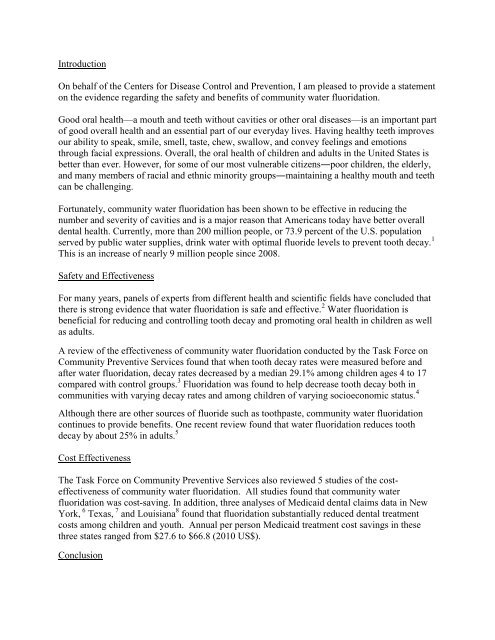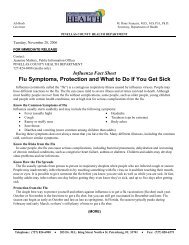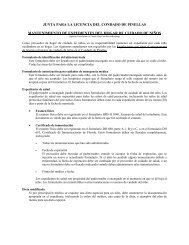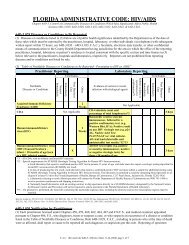STATEMENT ON THE EVIDENCE SUPPORTING THE SAFETY ...
STATEMENT ON THE EVIDENCE SUPPORTING THE SAFETY ...
STATEMENT ON THE EVIDENCE SUPPORTING THE SAFETY ...
You also want an ePaper? Increase the reach of your titles
YUMPU automatically turns print PDFs into web optimized ePapers that Google loves.
Introduction<br />
On behalf of the Centers for Disease Control and Prevention, I am pleased to provide a statement<br />
on the evidence regarding the safety and benefits of community water fluoridation.<br />
Good oral health—a mouth and teeth without cavities or other oral diseases—is an important part<br />
of good overall health and an essential part of our everyday lives. Having healthy teeth improves<br />
our ability to speak, smile, smell, taste, chew, swallow, and convey feelings and emotions<br />
through facial expressions. Overall, the oral health of children and adults in the United States is<br />
better than ever. However, for some of our most vulnerable citizens―poor children, the elderly,<br />
and many members of racial and ethnic minority groups―maintaining a healthy mouth and teeth<br />
can be challenging.<br />
Fortunately, community water fluoridation has been shown to be effective in reducing the<br />
number and severity of cavities and is a major reason that Americans today have better overall<br />
dental health. Currently, more than 200 million people, or 73.9 percent of the U.S. population<br />
served by public water supplies, drink water with optimal fluoride levels to prevent tooth decay. 1<br />
This is an increase of nearly 9 million people since 2008.<br />
Safety and Effectiveness<br />
For many years, panels of experts from different health and scientific fields have concluded that<br />
there is strong evidence that water fluoridation is safe and effective. 2 Water fluoridation is<br />
beneficial for reducing and controlling tooth decay and promoting oral health in children as well<br />
as adults.<br />
A review of the effectiveness of community water fluoridation conducted by the Task Force on<br />
Community Preventive Services found that when tooth decay rates were measured before and<br />
after water fluoridation, decay rates decreased by a median 29.1% among children ages 4 to 17<br />
compared with control groups. 3 Fluoridation was found to help decrease tooth decay both in<br />
communities with varying decay rates and among children of varying socioeconomic status. 4<br />
Although there are other sources of fluoride such as toothpaste, community water fluoridation<br />
continues to provide benefits. One recent review found that water fluoridation reduces tooth<br />
decay by about 25% in adults. 5<br />
Cost Effectiveness<br />
The Task Force on Community Preventive Services also reviewed 5 studies of the costeffectiveness<br />
of community water fluoridation. All studies found that community water<br />
fluoridation was cost-saving. In addition, three analyses of Medicaid dental claims data in New<br />
York, 6 Texas, 7 and Louisiana 8 found that fluoridation substantially reduced dental treatment<br />
costs among children and youth. Annual per person Medicaid treatment cost savings in these<br />
three states ranged from $27.6 to $66.8 (2010 US$).<br />
Conclusion

















